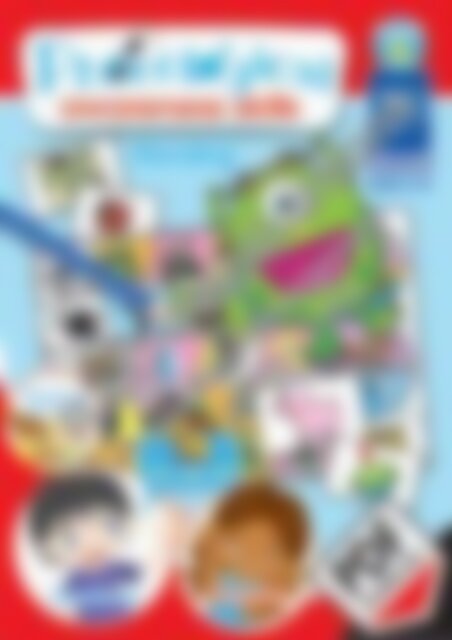20814_Unit_5_Blending
You also want an ePaper? Increase the reach of your titles
YUMPU automatically turns print PDFs into web optimized ePapers that Google loves.
Phonological awareness skills<br />
<strong>Unit</strong> 5 – <strong>Blending</strong><br />
Published by R.I.C. Publications ® 2018<br />
Copyright © R.I.C. Publications ® 2018<br />
RIC– <strong>20814</strong><br />
Titles in this series:<br />
Phonological awareness skills <strong>Unit</strong> 1 – Auditory discrimination<br />
Phonological awareness skills <strong>Unit</strong> 2 – Rhyming<br />
Phonological awareness skills <strong>Unit</strong> 3 – Alliteration<br />
Phonological awareness skills <strong>Unit</strong> 4 – Segmentation and syllabification<br />
Phonological awareness skills <strong>Unit</strong> 5 – <strong>Blending</strong><br />
Phonological awareness skills <strong>Unit</strong> 6 – Phoneme matching<br />
Phonological awareness skills <strong>Unit</strong> 7 – Phoneme isolation<br />
Phonological awareness skills <strong>Unit</strong> 8 – Phoneme completion<br />
Phonological awareness skills <strong>Unit</strong> 9 – Phoneme addition and deletion<br />
Phonological awareness skills <strong>Unit</strong> 10 – Phoneme segmentation<br />
Phonological awareness skills <strong>Unit</strong> 11 – Phoneme substitution<br />
Phonological awareness skills <strong>Unit</strong> 12 – Phoneme reversal<br />
Phonological awareness skills <strong>Unit</strong> 13 – Phonological testing<br />
Disclaimer:<br />
This unit is for individual use only. It may not be uploaded to any<br />
computer network system or made available to others. It may not<br />
be reproduced beyond what the Copyright Act 1968 allows. It may<br />
not be modified or presented in a different format.<br />
Copyright Notice<br />
A number of pages in this book are<br />
worksheets. The publisher licenses the<br />
individual teacher who purchased this<br />
book to photocopy these pages to hand<br />
out to students in their own classes.<br />
Except as allowed under the Copyright Act<br />
1968, any other use (including digital and<br />
online uses and the creation of overhead<br />
transparencies or posters) or any use by<br />
or for other people (including by or for<br />
other teachers, students or institutions)<br />
is prohibited. If you want a licence to<br />
do anything outside the scope of the<br />
BLM licence above, please contact the<br />
Publisher.<br />
This information is provided to clarify the<br />
limits of this licence and its interaction<br />
with the Copyright Act.<br />
For your added protection in the case of<br />
copyright inspection, please complete the<br />
form below. Retain this form, the complete<br />
original document and the invoice or<br />
receipt as proof of purchase.<br />
Name of Purchaser:<br />
Date of Purchase:<br />
Supplier:<br />
School Order# (if applicable):<br />
Signature of Purchaser:<br />
Internet websites<br />
In some cases, websites or specific URLs may be recommended. While these are checked and rechecked at the time of publication,<br />
the publisher has no control over any subsequent changes which may be made to webpages. It is strongly recommended that the<br />
class teacher checks all URLs before allowing students to access them.<br />
View all pages online<br />
PO Box 332 Greenwood Western Australia 6924<br />
Website: www.ricpublications.com.au<br />
Email: mail@ricpublications.com.au
<strong>Unit</strong> 5<br />
PHONOLOGICAL AWARENESS SKILLS<br />
The general term ‘phonological awareness’ includes phonemic awareness of sounds, words,<br />
syllables and rhyme. All phonological and phonemic awareness skills are learnt orally.<br />
Children need the ability to identify and work with the sounds of spoken language in order to<br />
make sense of sound–symbol relationships.<br />
SKILL 5: BLENDING<br />
TEACHER NOTES<br />
What is phoneme blending?<br />
<strong>Blending</strong> is the process of combining individual spoken sounds/<br />
phonemes, in correct order, to make a word. Phonemes may be<br />
individual letters such as h/a/t or groups of letters such as th/i/ck.<br />
Young children are exposed to blending early through rhyming.<br />
In essence, rhyming is the process of blending a new onset<br />
(everything before the vowel sound in a word) to an old rime<br />
(the vowel sound and everything after it in a word).<br />
Teachers should demonstrate the process often before<br />
expecting children to attempt blending.<br />
Levels of phonological awareness<br />
word<br />
Phoneme blending and phoneme segmentation are best<br />
taught together.<br />
Why is phoneme blending important?<br />
Saying and blending individual phonemes makes children<br />
aware that a series of sounds make up a word.<br />
<strong>Blending</strong> is an important skill for reading. As children encounter unfamiliar words, they<br />
can see letters in words, say and blend the individual sounds the letters make and this will<br />
help them to work out and read the word. As time progresses and children become more<br />
competent using this skill, blending becomes smoother and faster and children read more<br />
fluently.<br />
Children with good blending skills develop better literacy skills than those without.<br />
What does phoneme blending involve?<br />
Phoneme blending may include the ability to:<br />
• blend syllables in a word. For example, snow/ball, rain/bow, un/der, pen/cil, out/side.<br />
(Begin with two then three syllables.)<br />
• blend onset/rime in a word. For example, br/ush, t/alk etc.<br />
syllable<br />
onset and rime<br />
phoneme<br />
• blend individual phonemes. (Begin with two phonemes to make words, then progress to<br />
three and four phonemes.)<br />
• blend individual phonemes such as ‘s’ and ‘m’ to generate consonant blends for more<br />
difficult words. For example, s/m—smile, dr/ess, l/a/mp. (Consonant blends include both<br />
those at the beginning and those at the end of words.)<br />
R.I.C. Publications ® www.ricpublications.com.au PHONOLOGICAL AWARENESS SKILLS — BLENDING 1
TEACHER NOTES (continued)<br />
The use of phonemes to make nonsense words will indicate whether children fully grasp the<br />
process of blending.<br />
What is the best way to support children as they learn about blending?<br />
As always, the most effective instruction method for any reading skill is modelling. Model<br />
blending in a number of different ways, always being slow, clear and correct. Increase the<br />
speed of the sounds delivery until the children become proficient.<br />
Teachers need to say phonemes clearly and correctly, even exaggerated, without adding<br />
unnecessary additional sounds, so that it is easier for children to hear and blend sounds; and<br />
understand the process.<br />
Visit to read about body–coda blending<br />
which some experts believe is easier than onset–rime blending, especially for older children<br />
writing and spelling words.<br />
What things do I need to remember when modelling blending?<br />
• Some letter sounds can be lengthened and held for a length of time. Others, however,<br />
when lengthened, may change the sound.<br />
Sounds that can be elongated<br />
and held continuously<br />
Sounds that CANNOT be<br />
elongated and held continuously<br />
a, e, f, i, l, m, n, o, r, s, u, v, w, y, z b, c, d, g, h, j, k, p, q, t, x<br />
These sounds are easier to blend so<br />
instruction should commence with these.<br />
Use words such as fan, sum, fuzz etc.<br />
Hold for 1 or 2 seconds and blend<br />
smoothly with the next sound.<br />
These sounds are more difficult to<br />
blend without changing the sound,<br />
so introduce these gradually.<br />
Say the sound once only, pause for 1<br />
or 2 seconds, then say the next sound,<br />
elongating this sound for 1 or 2 seconds<br />
• Always use plenty of visual support, pointing to pictures when learning blending. Visual<br />
representations aid memory of sounds.<br />
• Introduce letters for sounds only when you feel the children are ready to grasp the<br />
concept.<br />
• When slowly sounding out a word such as ‘rrrruuunnnn’, point to each letter as each sound<br />
is pronounced.<br />
• Ensure that all senses are engaged, as children will benefit from hands-on activities.<br />
Counters and markers should be used, or the children can ‘run’ a small plastic car over the<br />
letters on a card as they say the sounds slowly.<br />
2<br />
PHONOLOGICAL AWARENESS SKILLS — BLENDING R.I.C. Publications ® www.ricpublications.com.au
<strong>Unit</strong> 5<br />
BLENDING games and activities<br />
ACTIVITY 1: Immersion in playing with sounds<br />
Read books with the children like the ones below that manipulate sounds and<br />
blend them in interesting, and often funny ways.<br />
• Demonstrate the process of blending • Immerse children in sound play<br />
ACTIVITY 2: Sound train<br />
Equipment required: Wooden train set and coloured blocks, or beads and<br />
string<br />
Instructions: Decide on simple two-sound words such as on, at, is or a CVC word<br />
such as box, hat or cap to demonstrate the process.<br />
Say the individual sounds that make up the word, and as each sound is stated,<br />
place one coloured block on the train (or thread one bead on the string). Use<br />
different coloured blocks or beads for each different sound.<br />
Repeat the sounds and ask, ‘What word do those sounds make?’<br />
With each successive blending, the train rolls around the track and a selected<br />
child can make train noises.<br />
R.I.C. Publications ® www.ricpublications.com.au PHONOLOGICAL AWARENESS SKILLS — BLENDING 3
<strong>Unit</strong> 5<br />
BLENDING games and activities<br />
ACTIVITY 3: Feed the monster<br />
Materials required: Large cardboard cutout of a monster, firmly attached to<br />
the end of a shoebox; blank squares of different coloured<br />
cardboard (one for each different sound used)<br />
Instructions: Decide on a simple two-sound word such as on, at, is or a CVC<br />
word such as box or hat or cat to demonstrate the process.<br />
Say the individual sounds that make<br />
up the word, and as each sound is<br />
stated, ‘feed’ one coloured square<br />
of cardboard into the monster’s<br />
mouth.<br />
Refer to page 20 for an example of<br />
a monster outline to use.<br />
* For those children who are<br />
developing letter–sound<br />
correspondence, individual<br />
sounds written on cards may be<br />
used.<br />
ACTIVITY 4: What word is that?<br />
Materials required: Pictures of simple, familiar objects<br />
Instructions: Place three different picture cards face up on the floor and ask<br />
children to name each one. Explain that you are going to say the<br />
sounds that name one picture. Say each sound in the chosen<br />
words, stretching out the sounds then blending them to make the<br />
word.<br />
The children have to point to the picture that<br />
matches the word.<br />
Encourage children to repeat the sounds<br />
and ‘run them together’ to make the word.<br />
Repeat a number of times using different<br />
pictures.<br />
This activity is best carried out in small<br />
groups.<br />
Refer to page 20 for pictures to use.<br />
• Demonstrate the process of blending • Demonstrate the process of blending<br />
4<br />
PHONOLOGICAL AWARENESS SKILLS — BLENDING R.I.C. Publications ® www.ricpublications.com.au
<strong>Unit</strong> 5<br />
BLENDING games and activities<br />
• Demonstrate the process of blending<br />
ACTIVITY 5: <strong>Blending</strong> sounds and animals book<br />
Visit to watch a<br />
demonstration of how to use a split board book to<br />
create crazy animals and blend three phonemes.<br />
The teacher flips over the sections of the book to<br />
create an unusual animal.<br />
A counter, marker or plastic animal is placed on the<br />
initial, middle and final sections of the picture while the<br />
teacher says each sound. Then the sounds are blended<br />
together to generate a word which the children repeat.<br />
To be more explicit, each new sound should have a different object to represent<br />
it. If the sound is repeated, as in pop, the same object should be repeated in the<br />
initial and final positions to create a better visual representation of the sounds in<br />
the word.<br />
The site above provides a free sample to download and the book can be<br />
purchased quite cheaply.<br />
<strong>Blending</strong> books are similar in concept to Elkonin boxes (but more motivating).<br />
Some examples of animal pages are provided on pages 21–28.<br />
ACTIVITY 6: Compound words<br />
Say pairs of small words, then blend them together to make compound words.<br />
For example, in/side, snow/ball, cross/walk, out/side, grass/hopper, basket/ball,<br />
butter/flies, rattle/snake, sun/flower, moon/light, tooth/brush, back/bone etc.<br />
Use picture card clues where possible to assist children.<br />
Some picture card examples are provided on pages 29–30.<br />
• Blend small words to make compound words<br />
toothbrush<br />
R.I.C. Publications ® www.ricpublications.com.au PHONOLOGICAL AWARENESS SKILLS — BLENDING 5
<strong>Unit</strong> 5<br />
BLENDING games and activities<br />
ACTIVITY 7: <strong>Blending</strong> syllables<br />
Select a two-syllable word and say each syllable separately.<br />
For example, un/der, pen/cil, ap/ple, un/til, mar/ket etc.<br />
Then ‘run’ the syllables closer together.<br />
Ask children, ‘What word is that?’<br />
Commence with two-syllable words and progress to three- and four-syllable<br />
words.<br />
Possible words to use:<br />
Two-syllable words<br />
let/ter, box/er, lad/der, tur/nip, pur/ple, Thurs/day, sil/ver, piz/za, a/gain,<br />
wa/ter, hap/py, o/ver, a/ble, na/ture, cit/y<br />
Three-syllable words<br />
ba/nan/a, pi/a/no, cel/e/brate, an/i/mal, Sat/ur/day, po/ta/to, el/e/phant,<br />
a/maz/ing, ad/ven/ture, im/por/tant, dan/ger/ous, hol/i/day, to/geth/er<br />
Four-syllable words<br />
Jan/u/ar/y, in/for/ma/tion, in/ter/est/ing, al/li/ga/tor, wa/ter/me/lon,<br />
tel/e/vi/sion, in/vis/i/ble, a/quar/i/um, cat/er/pil/lar, hel/i/cop/ter,<br />
a/dor/a/ble<br />
wa/ter/mel/on<br />
• Blend syllables to make words<br />
ACTIVITY 8: <strong>Blending</strong> onset and rime<br />
Onset: The first sound before the vowel in a word<br />
Rime: The last part of the word which includes the vowel.<br />
For example, b (onset), ug (rime)<br />
Use picture cards of common objects of one syllable like those on pages 31<br />
and 32. For example, mug, cup, dog, mat, lamp, hat, peg, door, bed, milk,<br />
bread, sock, tree etc.<br />
Place a set of three or four picture cards on the floor and say a word segmented<br />
into onset and rime.<br />
Ask children to blend the parts of the words and to point to the picture that<br />
indicates the word.<br />
Increase the number of picture cards to choose from to increase the difficulty<br />
level.<br />
pl/ate<br />
plate<br />
• Blend onset and rime to make words<br />
6<br />
PHONOLOGICAL AWARENESS SKILLS — BLENDING R.I.C. Publications ® www.ricpublications.com.au
<strong>Unit</strong> 5<br />
BLENDING games and activities<br />
• Blend onset and rime to make words<br />
ACTIVITY 9: I spy (An onset and rime blend)<br />
Play a version of ‘I spy’ with objects around the room, using onset and rime.<br />
Say, for example, ‘I spy with my little eye something that has “cl” and “ock”. What<br />
did I spy?’<br />
The children have to blend the onset and rime to make the word and work out<br />
the object.<br />
Examples may include: b/ook, p/en, br/ush, ch/air, t/ap, m/at, ch/alk, b/oard,<br />
fl/oor, w/all, b/ag, l/unch, dr/ink etc.<br />
This activity may also be used<br />
in conjunction with books such<br />
as the one shown. Children<br />
search for blends for other<br />
objects such as animals.<br />
• Blend onset and rime to make words<br />
ACTIVITY 10: Letter/sound onset–rime blending<br />
Use onset–rime word chunks with more capable children who can match the<br />
letter to the sound to make word families. Plastic letters or letters on cards<br />
should be manipulated while completing this activity.<br />
Place a written rime such as ‘–at’ on the table or floor in front<br />
of the child or small group of children using plastic letters.<br />
Sound and blend ‘a’ and ‘t’ with the children to make ‘–at’.<br />
Say ‘Let’s add another letter at the front (the onset) to make a new word.’<br />
Demonstrate how to add ‘c’, ‘m’, ‘s’ etc. to the rime ‘at’. Say the onset and rime<br />
and blend to make each word. Have children repeat the blending process and<br />
word created.<br />
Select children to create other ‘–at’ words until a word family is created.<br />
Other word families to create include: –ack, –ame, –ell, –ight, –ink, –op, –ump,<br />
–all, –an, –ate, –est, –ill, –ip, –ore, –unk, –ain, –ank, –aw, –in, –it, –or, –ake, –ap, –ay,<br />
–ick, –ine, –ock, –uck, –ale, –ash, –eat, –ide, –ing, –oke and –ug.<br />
The cards on pages 33–35 can be used with children adding a plastic letter to<br />
the front of the rime. If words are created that make nonsense words, ask ‘Is this<br />
a real or nonsense word?’ (Scrabble® pieces may also be used.)<br />
R.I.C. Publications ® www.ricpublications.com.au PHONOLOGICAL AWARENESS SKILLS — BLENDING 7
<strong>Unit</strong> 5<br />
BLENDING games and activities<br />
ACTIVITY 11: Sound riddles<br />
Say these instructions to the children:<br />
‘I am going to say the separate sounds that make up a word. I want you to blend<br />
the sounds together and tell me what the word is.’<br />
Select a word, such as t/r/u/ck and say the separate sounds.<br />
The children listen to the sounds, blend them to make the word, and give their<br />
answer.<br />
Use shorter words to begin, and progress to longer, more difficult words. (See<br />
examples below.)<br />
Children should be encouraged to think of their own words and share them as<br />
individual sounds for others to blend.<br />
One-syllable word examples<br />
dog<br />
cat<br />
truck<br />
house<br />
road<br />
bed<br />
d/o/g<br />
c/a/t<br />
t/r/u/ck<br />
h/ou/se<br />
r/oa/d<br />
b/e/d<br />
Two-syllable word examples<br />
window<br />
necklace<br />
jacket<br />
teacher<br />
monkey<br />
paper<br />
w/i/n/d/ow<br />
n/e/ck/l/a/ce<br />
j/a/ck/e/t<br />
t/ea/ch/er<br />
m/o/n/k/ey<br />
p/a/per<br />
• Blend individual phonemes<br />
ACTIVITY 12: Robot talk<br />
The teacher acts as the robot leader and repeats the rhyme in a robot-like<br />
voice.<br />
‘I am a robot. Can you help me?<br />
When I say the sounds, can you tell me what I<br />
see?’<br />
Then the teacher says two or three sounds such<br />
as /m/ /a/ /n/.<br />
The children repeat the rhyme in their own<br />
robot voice and after repeating the sounds,<br />
blend the sounds to make a word.<br />
The children then say, ‘I can help you. I know<br />
what you see. You see .’<br />
(blended word)<br />
When children are proficient playing the game<br />
this way, they may be chosen to be the robot<br />
leader.<br />
• Blend individual phonemes<br />
8<br />
PHONOLOGICAL AWARENESS SKILLS — BLENDING R.I.C. Publications ® www.ricpublications.com.au
<strong>Unit</strong> 5<br />
BLENDING games and activities<br />
ACTIVITY 13: The sound-blending song<br />
Sing this song to the tune ‘If you’re happy and you know it ...’<br />
If you think you know this word, shout it out!<br />
If you think you know this word, shout it out!<br />
If you think you know this word,<br />
Then tell me what you’ve heard,<br />
If you think you know this word, shout it out!<br />
After singing, the teacher says a segmented<br />
word such as /h/ /u/ /t/ and the children<br />
provide the blended word hut.<br />
ACTIVITY 14: <strong>Blending</strong> names<br />
Use the children’s names to practise blending. This activity may be used at<br />
various times during the day—to allow children to go to lunch or recess, or to an<br />
activity.<br />
Say, for example, ‘The person to go is J/a/ck.’<br />
The children blend the sounds and say the name of the child. Children should<br />
be encouraged to provide the answers and think about how their own name<br />
can be segmented into individual sounds and blended.<br />
• Blend individual phonemes<br />
• Blend individual phonemes<br />
R.I.C. Publications ® www.ricpublications.com.au PHONOLOGICAL AWARENESS SKILLS — BLENDING 9
<strong>Unit</strong> 5<br />
BLENDING games and activities<br />
ACTIVITY 15: Elkonin boxes<br />
Provide each child with an Elkonin box card which has been photocopied,<br />
laminated and cut out. Use the examples on page 42. They will also need three<br />
counters of different colours.<br />
Select a picture of a familiar object. (The cards on pages 38–40 may be used.)<br />
The names of the objects should be made up of three sounds or less. For<br />
example, c/oa/t, b/a/t. Place the card so the child cannot see what it is.<br />
Say to the child, ‘I am going to say the sounds that make up the name of the<br />
object.’ Ask them to repeat the sounds that make up the name of the object.<br />
Then for each sound, the child places one counter in each box.<br />
Say ‘Can you blend/run the sounds together and tell me what object I chose?’<br />
Children blend the sounds and give an answer.<br />
Check to see if they are correct by displaying the<br />
picture.<br />
Letters for sounds are not used at this stage but<br />
may be included for more capable children.<br />
ACTIVITY 16: The take away game<br />
Say the individual phonemes for a word, such as ‘log’—l/o/g, then blend them<br />
and, with the children, work out the word.<br />
Then say, ‘Let’s take away a sound. We’ll take away the “l” sound. What do we<br />
have left —“o/g”? Let’s blend them and see what the sounds make—“og”. Is that a<br />
real or nonsense word?’<br />
Repeat with other CVC words, commencing with the initial sound then the final<br />
sound. Initial consonant sounds such as ‘bl’, ‘cr’ etc. may also be used.<br />
log – l = og<br />
dress – dr = ess<br />
This activity may also be used for phoneme addition.<br />
Elkonin boxes<br />
• Blend individual phonemes • Blend individual phonemes<br />
10<br />
PHONOLOGICAL AWARENESS SKILLS — BLENDING R.I.C. Publications ® www.ricpublications.com.au
<strong>Unit</strong> 5<br />
BLENDING games and activities<br />
• Blend individual phonemes<br />
ACTIVITY 17: Four blends in a row<br />
Play this game with up to six children.<br />
This game requires the set of segmented word cards on page 37 and the game<br />
boards on pages 38–40, which should be cut out and laminated prior to playing.<br />
Each child needs a game board and counters or markers.<br />
Select one segmented word<br />
card and say the sounds.<br />
The children must blend<br />
the sounds to work out<br />
the words. If they have the<br />
picture relating to that word<br />
on their card, they place<br />
a counter/marker on their<br />
board. The first child to get<br />
four counters/markers in a<br />
row wins the game.<br />
m/o/p c/a/t m/a/p p/i/g<br />
t/o/p b/u/g s/u/n j/e/t<br />
r/a/n h/a/t p/a/n w/i/g<br />
f/i/n d/o/t n/e/s/t l/o/g<br />
p/i/n t/e/n t/u/b f/a/n<br />
l/i/p s/a/d v/a/n c/a/n<br />
h/a/n/d t/a/p n/e/t p/o/t<br />
• Blend individual phonemes<br />
ACTIVITY 18: Online blending games<br />
The following list of online games vary<br />
from simple introductions to more<br />
complicated games.<br />
• <br />
practise blending sounds for reading<br />
CVC words<br />
• <br />
blending sounds word builder game<br />
for kids (Educational learning video)<br />
• The<br />
Reading Machine 2<br />
• <br />
Phonics | phase 2 | set 2 words | learn<br />
to blend | letters and sounds | cvc<br />
words s a t p i n m d<br />
R.I.C. Publications ® www.ricpublications.com.au PHONOLOGICAL AWARENESS SKILLS — BLENDING 11
<strong>Unit</strong> 5<br />
BLENDING games and activities<br />
ACTIVITY 19: <strong>Blending</strong> board<br />
Create a blending board to use when blending letters to make simple CVC<br />
words.<br />
Visit to find<br />
the instructions.<br />
Arrows on each letter indicate the direction of blending.<br />
Commercially-made blending boards are also available.<br />
• Blend individual phonemes<br />
ACTIVITY 20: <strong>Blending</strong> flip book<br />
For more capable children who have a good grasp of letter–sound<br />
correspondence, consider creating a ‘flip book’ in a large binder. The individual<br />
phonemes can be ‘flipped’ over to create a wide variety of words and<br />
consolidate sounds already taught.<br />
A binder with side clips or spirals may be used. Teachers can make their own flip<br />
book as easy or difficult as they like.<br />
• Blend individual phonemes<br />
12<br />
PHONOLOGICAL AWARENESS SKILLS — BLENDING R.I.C. Publications ® www.ricpublications.com.au
<strong>Unit</strong> 5<br />
BLENDING games and activities<br />
ACTIVITY 21: Craft stick blending<br />
Use pictures and letters for vowels glued onto craft sticks to practise blending.<br />
The children manipulate and blend consonants and vowels to make their own<br />
words.<br />
Completed words can be ‘stuck’ in a lump of flattened playdough or some<br />
florist foam for display.<br />
• Blend individual phonemes<br />
ACTIVITY 22: <strong>Blending</strong> flip game<br />
Write consonants on blank playing cards. Write the number ‘1’ at the bottom.<br />
Write consonants on another set but label these ‘3’. Write vowels on another set<br />
of 5 cards. Label and number these ‘2’.<br />
The cards are numbered so children know where to place them.<br />
Place all the cards in piles as shown on the diagram. Children ‘flip’ the cards<br />
over to create real or nonsense words.<br />
The game is for two children but an adult helper assists.<br />
• Blend individual phonemes<br />
R.I.C. Publications ® www.ricpublications.com.au PHONOLOGICAL AWARENESS SKILLS — BLENDING 13
<strong>Unit</strong> 5<br />
BLENDING games and activities<br />
ACTIVITY 23: Race car blending<br />
This activity uses plastic racing cars to play a blending game.<br />
Write CVC words on pieces of black card using a white crayon. Write ‘Start’ and<br />
‘Finish’ at the beginning and end of each track.<br />
The children blend sounds to make a word as they move a car along the track.<br />
ACTIVITY 24: CVC word board games<br />
Use the game board on page 41 to practise short vowel sounds in CVC words.<br />
A dice is required to play the game.<br />
Each player sounds out and blends<br />
to read each word they land on.<br />
The first to the end wins.<br />
• Blend individual phonemes • Blend individual phonemes<br />
14<br />
PHONOLOGICAL AWARENESS SKILLS — BLENDING R.I.C. Publications ® www.ricpublications.com.au
<strong>Unit</strong> 5<br />
BLENDING games and activities<br />
ACTIVITY 25: Introducing consonant blending<br />
Children are not ready to blend consonants until they have a thorough<br />
knowledge of all individual letter sounds.<br />
Introduce consonant blends in the following manner.<br />
Say ‘I am thinking of a blend that uses two sounds. Can you tell me what it is?’<br />
Say the sounds ‘b’ and ‘l’. ‘What blend does it make?’<br />
Have children say the sounds and blend them to make ‘bl’.<br />
Repeat with c + l = cl, f + l = fl, p + l = pl, g + l = gl and s + l = sl.<br />
Ask children to say any words they know that have those blends at the front of<br />
the word.<br />
Begin with two-letter consonant blends at the beginning of words before<br />
progressing to three-letter blends and those at the end like ‘mp’.<br />
A table listing all major consonant blends can be found on page 43.<br />
(If children are capable, write b + l = bl on the board and get them to write it on<br />
individual whiteboards.)<br />
ACTIVITY 26: Clip the blend<br />
Glue images of everyday objects beginning with consonant blends onto file<br />
cards.<br />
At the bottom write consonant blends and beginning sounds.<br />
Images may include:<br />
street, tree, grass, block, flag, crab, plant,<br />
clap, fly, glasses, play, sleep, brick, creek,<br />
crook, dress, frog, pram, drum, smile,<br />
snack, stick, swim, twins, cream, clip,<br />
snake, spoon etc.<br />
Children use a peg to clip the beginning<br />
sound of the word from choices given<br />
below each picture. The choices include<br />
single consonants and two-consonant<br />
blends.<br />
• Blend consonants<br />
• Blend consonants<br />
R.I.C. Publications ® www.ricpublications.com.au PHONOLOGICAL AWARENESS SKILLS — BLENDING 15
<strong>Unit</strong> 5<br />
BLENDING games and activities<br />
ACTIVITY 27: Which consonant blend?<br />
Write constonant blends onto cardboard<br />
grids to make bingo boards as shown in<br />
the picture. Images like those suggested<br />
in ‘Clip the blend’ are glued onto small<br />
cards.<br />
Counters or whiteboard markers are<br />
needed to play the game.<br />
Players choose a game board each on<br />
which blends are written. The picture<br />
cards are placed face down and players<br />
take turns taking a picture, naming the<br />
object and stating the beginning blend.<br />
All players then place a counter or use the<br />
marker to cross that blend on their game<br />
card. Players continue in this way until one<br />
player has three blends in a row or has<br />
completed the whole board.<br />
• Blend consonants<br />
ACTIVITY 28: Learning about blends<br />
Use the game board on page 44* for this activity. Players need a counter,<br />
marker and a dice.<br />
Players throw a dice and move that number of spaces from the mouse at the<br />
start.<br />
Players say each consonant blend and name the picture to hear the blend<br />
relating to the image they land on.<br />
The first player to the cheese<br />
wins.<br />
Any images ‘missed’ while<br />
playing should be identified by<br />
the players when the game is<br />
finished.<br />
* This resource is titled ‘Help<br />
the mouse find the cheese’<br />
blending game—1<br />
• Blend consonants<br />
16<br />
PHONOLOGICAL AWARENESS SKILLS — BLENDING R.I.C. Publications ® www.ricpublications.com.au
<strong>Unit</strong> 5<br />
BLENDING games and activities<br />
• Blend consonants<br />
ACTIVITY 29: Word slider for blends<br />
Use a large paper plate and a strip of cardboard to make a word slider to<br />
practise blending beginning consonants for word families.<br />
Write the word ending/word family in large print slightly to the right of the<br />
plate’s centre.<br />
Cut a strip of cardboard, and, with even spaces between<br />
them, write consonant beginnings. Some consonant<br />
blends or digraphs may be included if children are<br />
familiar with them. Otherwise single sounds should be<br />
used. The strip of paper should be a little narrower than<br />
the width of the slits cut in the paper plate.<br />
On the plate, to the left of the word family ending,<br />
cut 2 slits slightly wider than the width of the strip of<br />
cardboard on which the word beginnings have been<br />
written.<br />
Insert the cardboard strip through the slits and slide<br />
it through until the word beginning lines up with the<br />
endings. Blend to say a word.<br />
• Blend consonants<br />
ACTIVITY 30: Help the mouse find the cheese<br />
This game should be played with more capable students. Play with two or more<br />
players to practise consonant blends. You will need a dice.<br />
Enlarge and print the game<br />
board on page 45. Laminate<br />
before using.<br />
Players take turns to throw<br />
a dice and move that many<br />
spaces around the board.<br />
When players land on a space,<br />
they say the blend and name a<br />
word beginning with the blend.<br />
If a player lands on a smiley<br />
face, they take another turn.<br />
The first player to reach the<br />
cheese wins.<br />
R.I.C. Publications ® www.ricpublications.com.au PHONOLOGICAL AWARENESS SKILLS — BLENDING 17
<strong>Unit</strong> 5<br />
BLENDING games and activities<br />
ACTIVITY 31: Blends toss<br />
Use this game with very capable children.<br />
You will need: 5 or 6 paper cups; coins, buttons or small, foam balls; tape;<br />
markers; pencils and paper for recording words; large muffin<br />
tray in which to stand cups for stability (optional); large sheet<br />
butcher’s paper<br />
Using a permanent marker, write a blend on each<br />
paper cup at the top on the inside. Select those the<br />
children are familiar with.<br />
Place each paper cup in the muffin tin to keep it<br />
secure.<br />
Draw a table on the butcher’s paper and write the<br />
consonant blends at the top of the columns.<br />
The children take turns tossing a coin/button/ball<br />
into a cup. When it lands, the child must think of a<br />
word that begins with that blend. The word is then<br />
written in the correct column of the table.<br />
Tally the words at the end of a specified time frame.<br />
• Blend consonants<br />
ACTIVITY 32: Blends and digraphs bingo<br />
Make bingo boards with images<br />
of objects beginning with blends<br />
or digraphs.<br />
Images may include any objects<br />
mentioned in Activity 26, plus<br />
others like sheep, church, wheel<br />
and thread.<br />
Write the blends and digraphs<br />
onto blank playing cards.<br />
Players will need counters or<br />
markers to place on the bingo<br />
cards.<br />
The blend and digraph letter cards are placed face down in a pile. A card is<br />
chosen and the player sounds out and blends the consonants. If players have a<br />
picture that starts with that blend, they place a marker on it.<br />
The winner is the player who covers their bingo card first.<br />
Bingo cards with more images for more blends may also be used.<br />
• Blend consonants<br />
18<br />
PHONOLOGICAL AWARENESS SKILLS — BLENDING R.I.C. Publications ® www.ricpublications.com.au
<strong>Unit</strong> 5<br />
BLENDING games and activities<br />
‘Feed the monster’ outline<br />
R.I.C. Publications ® www.ricpublications.com.au PHONOLOGICAL AWARENESS SKILLS — BLENDING 19
<strong>Unit</strong> 5<br />
BLENDING games and activities<br />
‘What word is that?’ picture cards<br />
bell book fan<br />
duck boat mug<br />
cat key shoe<br />
bee bike road<br />
20<br />
PHONOLOGICAL AWARENESS SKILLS — BLENDING R.I.C. Publications ® www.ricpublications.com.au
<strong>Unit</strong> 5<br />
BLENDING games and activities<br />
<strong>Blending</strong> sounds and animals book—1<br />
R.I.C. Publications ® www.ricpublications.com.au PHONOLOGICAL AWARENESS SKILLS — BLENDING 21
<strong>Unit</strong> 5<br />
BLENDING games and activities<br />
<strong>Blending</strong> sounds and animals book—2<br />
22<br />
PHONOLOGICAL AWARENESS SKILLS — BLENDING R.I.C. Publications ® www.ricpublications.com.au
<strong>Unit</strong> 5<br />
BLENDING games and activities<br />
<strong>Blending</strong> sounds and animals book—3<br />
R.I.C. Publications ® www.ricpublications.com.au PHONOLOGICAL AWARENESS SKILLS — BLENDING 23
<strong>Unit</strong> 5<br />
BLENDING games and activities<br />
<strong>Blending</strong> sounds and animals book—4<br />
24<br />
PHONOLOGICAL AWARENESS SKILLS — BLENDING R.I.C. Publications ® www.ricpublications.com.au
<strong>Unit</strong> 5<br />
BLENDING games and activities<br />
<strong>Blending</strong> sounds and animals book—5<br />
R.I.C. Publications ® www.ricpublications.com.au PHONOLOGICAL AWARENESS SKILLS — BLENDING 25
<strong>Unit</strong> 5<br />
BLENDING games and activities<br />
<strong>Blending</strong> sounds and animals book—6<br />
26<br />
PHONOLOGICAL AWARENESS SKILLS — BLENDING R.I.C. Publications ® www.ricpublications.com.au
<strong>Unit</strong> 5<br />
BLENDING games and activities<br />
<strong>Blending</strong> sounds and animals book—7<br />
R.I.C. Publications ® www.ricpublications.com.au PHONOLOGICAL AWARENESS SKILLS — BLENDING 27
<strong>Unit</strong> 5<br />
BLENDING games and activities<br />
<strong>Blending</strong> sounds and animals book—8<br />
28<br />
PHONOLOGICAL AWARENESS SKILLS — BLENDING R.I.C. Publications ® www.ricpublications.com.au
<strong>Unit</strong> 5<br />
BLENDING games and activities<br />
<strong>Blending</strong> to make compound words picture cards—1<br />
butter<br />
fly<br />
jelly<br />
fish<br />
basket<br />
ball<br />
fire<br />
man<br />
R.I.C. Publications ® www.ricpublications.com.au PHONOLOGICAL AWARENESS SKILLS — BLENDING 29
<strong>Unit</strong> 5<br />
BLENDING games and activities<br />
<strong>Blending</strong> to make compound words picture cards—2<br />
tooth<br />
brush<br />
sun<br />
flower<br />
sand<br />
castle<br />
moon<br />
light<br />
30<br />
PHONOLOGICAL AWARENESS SKILLS — BLENDING R.I.C. Publications ® www.ricpublications.com.au
<strong>Unit</strong> 5<br />
BLENDING games and activities<br />
Onset–rime blending picture cards—1<br />
mug cup dog<br />
lamp mat hat<br />
pet door bed<br />
milk cat sock<br />
R.I.C. Publications ® www.ricpublications.com.au PHONOLOGICAL AWARENESS SKILLS — BLENDING 31
<strong>Unit</strong> 5<br />
BLENDING games and activities<br />
Onset–rime blending picture cards—2<br />
sun chair wall<br />
hen fork jam<br />
cap shoe mop<br />
pen egg pin<br />
32<br />
PHONOLOGICAL AWARENESS SKILLS — BLENDING R.I.C. Publications ® www.ricpublications.com.au
<strong>Unit</strong> 5<br />
BLENDING games and activities<br />
Onset–rime blending word family cards—1<br />
at an in<br />
it ap ip<br />
op ug ill<br />
ell all ack<br />
R.I.C. Publications ® www.ricpublications.com.au PHONOLOGICAL AWARENESS SKILLS — BLENDING 33
<strong>Unit</strong> 5<br />
BLENDING games and activities<br />
Onset–rime blending word family cards—2<br />
ump ock uck<br />
ick ink est<br />
ame ate ank<br />
unk oke ake<br />
34<br />
PHONOLOGICAL AWARENESS SKILLS — BLENDING R.I.C. Publications ® www.ricpublications.com.au
<strong>Unit</strong> 5<br />
BLENDING games and activities<br />
Onset–rime blending word family cards—3<br />
ide ing ine<br />
ice ight aw<br />
ay ale ash<br />
eat or ain<br />
R.I.C. Publications ® www.ricpublications.com.au PHONOLOGICAL AWARENESS SKILLS — BLENDING 35
<strong>Unit</strong> 5<br />
BLENDING games and activities<br />
Onset–rime blending word family cards—4<br />
b c d e f g<br />
h j k l m n<br />
p r s t v w<br />
y<br />
z<br />
36<br />
PHONOLOGICAL AWARENESS SKILLS — BLENDING R.I.C. Publications ® www.ricpublications.com.au
<strong>Unit</strong> 5<br />
BLENDING games and activities<br />
Segmented word cards<br />
m/o/p c/a/t m/a/p p/i/g<br />
t/o/p b/u/g s/u/n j/e/t<br />
r/a/n h/a/t p/a/n w/i/g<br />
f/i/n d/o/t n/e/s/t l/o/g<br />
p/i/n t/e/n t/u/b f/a/n<br />
l/i/p s/a/d v/a/n c/a/n<br />
h/a/n/d t/a/p n/e/t p/o/t<br />
R.I.C. Publications ® www.ricpublications.com.au PHONOLOGICAL AWARENESS SKILLS — BLENDING 37
<strong>Unit</strong> 5<br />
BLENDING games and activities<br />
‘Four blends in a row’ game board—1<br />
38<br />
PHONOLOGICAL AWARENESS SKILLS — BLENDING R.I.C. Publications ® www.ricpublications.com.au
<strong>Unit</strong> 5<br />
BLENDING games and activities<br />
‘Four blends in a row’ game board—2<br />
R.I.C. Publications ® www.ricpublications.com.au PHONOLOGICAL AWARENESS SKILLS — BLENDING 39
<strong>Unit</strong> 5<br />
BLENDING games and activities<br />
‘Four blends in a row’ game board—3<br />
40<br />
PHONOLOGICAL AWARENESS SKILLS — BLENDING R.I.C. Publications ® www.ricpublications.com.au
<strong>Unit</strong> 5<br />
BLENDING games and activities<br />
CVC word game board<br />
R.I.C. Publications ® www.ricpublications.com.au PHONOLOGICAL AWARENESS SKILLS — BLENDING 41
<strong>Unit</strong> 5<br />
BLENDING games and activities<br />
Elkonin boxes<br />
42<br />
PHONOLOGICAL AWARENESS SKILLS — BLENDING R.I.C. Publications ® www.ricpublications.com.au
<strong>Unit</strong> 5<br />
BLENDING games and activities<br />
Consonant blends lists<br />
Two-letter consonant blends—beginning of words<br />
bl<br />
as in<br />
black<br />
cl<br />
as in<br />
clap<br />
fl<br />
as in<br />
fly<br />
gl<br />
as in<br />
glad<br />
pl<br />
as in<br />
play<br />
sl<br />
as in<br />
slip<br />
br<br />
as in<br />
brick<br />
cr<br />
as in<br />
creek<br />
dr<br />
as in<br />
dress<br />
fr<br />
as in<br />
frog<br />
gr<br />
as in<br />
grab<br />
pr<br />
as in<br />
pram<br />
tr<br />
as in<br />
trip<br />
sc<br />
as in<br />
scale<br />
sk<br />
as in<br />
skunk<br />
sm<br />
as in<br />
smile<br />
sn<br />
as in<br />
snack<br />
sp<br />
as in<br />
span<br />
st<br />
as in<br />
stick<br />
sw<br />
as in<br />
swim<br />
tw<br />
as in<br />
twin<br />
Three-letter consonant blends—beginning of words<br />
str<br />
as in<br />
strike<br />
scr<br />
as in<br />
scream<br />
spr<br />
as in<br />
spring<br />
shr<br />
as in<br />
shrug<br />
thr<br />
as in<br />
three<br />
spl<br />
as in<br />
split<br />
Two-letter consonant blends—end of words and others<br />
nk<br />
as in<br />
sink<br />
lk<br />
as in<br />
milk<br />
nt<br />
as in<br />
went<br />
nd<br />
as in<br />
and<br />
mp<br />
as in<br />
lamp<br />
ft<br />
as in<br />
left<br />
sk<br />
as in<br />
mask<br />
ch<br />
as in<br />
chicken<br />
ck<br />
as in<br />
clock<br />
gh<br />
as in<br />
laugh<br />
ng<br />
as in<br />
sing<br />
sh<br />
as in<br />
fish<br />
th<br />
as in<br />
with<br />
wh<br />
as in<br />
when<br />
The bottom row, although consonants, are digraphs and<br />
must be taught individually.<br />
R.I.C. Publications ® www.ricpublications.com.au<br />
PHONOLOGICAL AWARENESS SKILLS — BLENDING<br />
43
<strong>Unit</strong> 5<br />
BLENDING games and activities<br />
‘Help the mouse find the cheese’ blending game—1<br />
44<br />
PHONOLOGICAL AWARENESS SKILLS — BLENDING R.I.C. Publications ® www.ricpublications.com.au
<strong>Unit</strong> 5<br />
BLENDING games and activities<br />
‘Help the mouse find the cheese’ blending game—2<br />
pr st cl fl<br />
sc fr<br />
cr<br />
sl str dr sk br<br />
fl<br />
gl sw fr sm pr gl<br />
sn<br />
pl fl<br />
dr bl sp sl gr cr tr<br />
sc squ br cl bl<br />
R.I.C. Publications ® www.ricpublications.com.au PHONOLOGICAL AWARENESS SKILLS — BLENDING 45
<strong>Unit</strong> 5<br />
‘Feed the monster’ outline<br />
BLENDING games and activities<br />
Black and white<br />
46 PHONOLOGICAL AWARENESS SKILLS — BLENDING R.I.C. Publications ® www.ricpublications.com.au
<strong>Unit</strong> 5<br />
BLENDING games and activities<br />
‘What word is that?’ picture cards<br />
Black and white<br />
bell book fan<br />
duck boat mug<br />
cat key shoe<br />
bee bike road<br />
R.I.C. Publications ® www.ricpublications.com.au<br />
PHONOLOGICAL AWARENESS SKILLS — BLENDING<br />
47
<strong>Unit</strong> 5<br />
BLENDING games and activities<br />
<strong>Blending</strong> sounds and animals book—1<br />
Black and white<br />
48 PHONOLOGICAL AWARENESS SKILLS — BLENDING R.I.C. Publications ® www.ricpublications.com.au
<strong>Unit</strong> 5<br />
BLENDING games and activities<br />
<strong>Blending</strong> sounds and animals book—2<br />
Black and white<br />
R.I.C. Publications ® www.ricpublications.com.au<br />
PHONOLOGICAL AWARENESS SKILLS — BLENDING<br />
49
<strong>Unit</strong> 5<br />
BLENDING games and activities<br />
<strong>Blending</strong> sounds and animals book—3<br />
Black and white<br />
50 PHONOLOGICAL AWARENESS SKILLS — BLENDING R.I.C. Publications ® www.ricpublications.com.au
<strong>Unit</strong> 5<br />
BLENDING games and activities<br />
<strong>Blending</strong> sounds and animals book—4<br />
Black and white<br />
R.I.C. Publications ® www.ricpublications.com.au<br />
PHONOLOGICAL AWARENESS SKILLS — BLENDING<br />
51
<strong>Unit</strong> 5<br />
BLENDING games and activities<br />
<strong>Blending</strong> sounds and animals book—5<br />
Black and white<br />
52 PHONOLOGICAL AWARENESS SKILLS — BLENDING R.I.C. Publications ® www.ricpublications.com.au
<strong>Unit</strong> 5<br />
BLENDING games and activities<br />
<strong>Blending</strong> sounds and animals book—6<br />
Black and white<br />
R.I.C. Publications ® www.ricpublications.com.au<br />
PHONOLOGICAL AWARENESS SKILLS — BLENDING<br />
53
<strong>Unit</strong> 5<br />
BLENDING games and activities<br />
<strong>Blending</strong> sounds and animals book—7<br />
Black and white<br />
54 PHONOLOGICAL AWARENESS SKILLS — BLENDING R.I.C. Publications ® www.ricpublications.com.au
<strong>Unit</strong> 5<br />
BLENDING games and activities<br />
<strong>Blending</strong> sounds and animals book—8<br />
Black and white<br />
R.I.C. Publications ® www.ricpublications.com.au<br />
PHONOLOGICAL AWARENESS SKILLS — BLENDING<br />
55
<strong>Unit</strong> 5<br />
BLENDING games and activities<br />
<strong>Blending</strong> to make compound words picture cards—1<br />
Black and white<br />
butter<br />
fly<br />
jelly<br />
fish<br />
basket<br />
ball<br />
fire<br />
man<br />
56 PHONOLOGICAL AWARENESS SKILLS — BLENDING R.I.C. Publications ® www.ricpublications.com.au
<strong>Unit</strong> 5<br />
BLENDING games and activities<br />
<strong>Blending</strong> to make compound words picture cards—2<br />
Black and white<br />
tooth<br />
brush<br />
sun<br />
flower<br />
sand<br />
castle<br />
moon<br />
light<br />
R.I.C. Publications ® www.ricpublications.com.au<br />
PHONOLOGICAL AWARENESS SKILLS — BLENDING<br />
57
<strong>Unit</strong> 5<br />
BLENDING games and activities<br />
Onset–rime blending picture cards—1<br />
Black and white<br />
mug cup dog<br />
lamp mat hat<br />
pet door bed<br />
milk cat sock<br />
58 PHONOLOGICAL AWARENESS SKILLS — BLENDING R.I.C. Publications ® www.ricpublications.com.au
<strong>Unit</strong> 5<br />
BLENDING games and activities<br />
Onset–rime blending picture cards—2<br />
Black and white<br />
sun chair wall<br />
hen fork jam<br />
cap shoe mop<br />
pen egg pin<br />
R.I.C. Publications ® www.ricpublications.com.au<br />
PHONOLOGICAL AWARENESS SKILLS — BLENDING<br />
59
<strong>Unit</strong> 5<br />
BLENDING games and activities<br />
‘Four blends in a row’ game board—1<br />
Black and white<br />
60 PHONOLOGICAL AWARENESS SKILLS — BLENDING R.I.C. Publications ® www.ricpublications.com.au
<strong>Unit</strong> 5<br />
BLENDING games and activities<br />
‘Four blends in a row’ game board—2<br />
Black and white<br />
R.I.C. Publications ® www.ricpublications.com.au<br />
PHONOLOGICAL AWARENESS SKILLS — BLENDING<br />
61
<strong>Unit</strong> 5<br />
BLENDING games and activities<br />
‘Four blends in a row’ game board—3<br />
Black and white<br />
62 PHONOLOGICAL AWARENESS SKILLS — BLENDING R.I.C. Publications ® www.ricpublications.com.au
<strong>Unit</strong> 5<br />
CVC word game board<br />
BLENDING games and activities<br />
Black and white<br />
R.I.C. Publications ® www.ricpublications.com.au<br />
PHONOLOGICAL AWARENESS SKILLS — BLENDING<br />
63
<strong>Unit</strong> 5<br />
BLENDING games and activities<br />
‘Help the mouse find the cheese’ blending game—1<br />
Black and white<br />
64 PHONOLOGICAL AWARENESS SKILLS — BLENDING R.I.C. Publications ® www.ricpublications.com.au
<strong>Unit</strong> 5<br />
BLENDING games and activities<br />
‘Help the mouse find the cheese’ blending game—2<br />
Black and white<br />
pr st cl fl<br />
sc fr<br />
cr<br />
sl str dr sk br<br />
fl<br />
gl sw fr sm pr gl<br />
sn<br />
pl fl<br />
dr bl sp sl gr cr tr<br />
sc squ br cl bl<br />
R.I.C. Publications ® www.ricpublications.com.au<br />
PHONOLOGICAL AWARENESS SKILLS — BLENDING<br />
65
<strong>Unit</strong> 5<br />
BLENDING ASSESSMENT—INDIVIDUAL<br />
1. Say these instructions to the child:<br />
‘I am going to say two little words. I want you to tell me the big word they make<br />
when they run together/are blended.’<br />
Say the following pairs of words. Then the child says the big word made when they<br />
are blended.<br />
sun/flower skate/board out/side table/spoon cow/boy<br />
wheel/barrow head/ache week/end court/yard tool/box<br />
sea/shore air/port bed/room birth/day match/stick<br />
tea/cup gold/fish eye/ball finger/print light/house<br />
2. Say these instructions to the child:<br />
‘I am going to say some words, but I am going to break them up into syllables. I<br />
want you to put the syllables together and tell me what the word is.’<br />
Say the syllables of some of the following words. Ask the child to blend the syllables<br />
and state the word. Repeat the syllables if necessary.<br />
Two-syllable words<br />
ba/sket mon/key kit/ten nap/kin gar/den wag/on<br />
ca/mel piz/za let/ter ci/ty lad/der yel/low<br />
Three-syllable words<br />
pho/to/graph lem/on/ade py/ja/mas el/e/phant<br />
rad/i/o ban/a/na neigh/bour/hood furn/i/ture<br />
Four-syllable words<br />
cat/er/pil/lar al/li/ga/tor hel/i/cop/ter wa/ter/mel/on<br />
un/der/wa/ter al/to/geth/er Feb/ru/a/ry av/o/ca/do<br />
3. Say these instructions to the child:<br />
‘I am going to say the beginning and end of a word. I want you to run them<br />
together/blend them and tell me what word it makes.’<br />
Say the following onsets and rimes. The child repeats them and says the word each<br />
makes.<br />
m/ug p/it h/am r/at p/en t/in<br />
m/ad s/ad c/ab b/ed r/od h/ut<br />
d/og f/ix g/oat j/ar l/id n/od<br />
66<br />
PHONOLOGICAL AWARENESS SKILLS — BLENDING R.I.C. Publications ® www.ricpublications.com.au
<strong>Unit</strong> 5<br />
BLENDING ASSESSMENT—INDIVIDUAL<br />
4. Say these instructions to the child:<br />
‘I am going to show you three pictures. Then I am going to say some sounds. I want<br />
you to blend the sounds together and point to the picture that matches the word.’<br />
Use the pictures on page 20.<br />
Say the following sounds while the child listens. Repeat if necessary. Then ask the<br />
child to blend the sounds to make a word and point to the picture that matches the<br />
word.<br />
b/e/ll—bell b/oo/k—book f/a/n—fan d/u/ck—duck<br />
b/oa/t—boat m/u/g c/a/t—cat k/ey—key<br />
sh/oe—shoe b/ee—bee b/i/ke—bike r/oa/d—road<br />
5. Say these instructions to the child:<br />
‘I am going to say two sounds and I want you to tell me what word they make when<br />
they run together.’<br />
Choose from the following groups of sounds. The child blends the sounds and<br />
states the word. Begin with two phonemes and progress to three or four for more<br />
capable children. Once it is obvious that the child can blend successfully, there is no<br />
need to proceed.<br />
Two-phoneme words<br />
o/n—on a/t—at i/s—is i/t—it u/p—up a/m—am<br />
b/ee—bee e/gg—egg d/ay—day h/e—he z/oo—zoo a/te—ate<br />
Three-phoneme words<br />
a/n/d—and a/n/t—ant f/i/n—fin d/o/g—dog f/oo/t—foot<br />
r/ea/d—read r/i/p—rip l/a/ke—lake r/oa/d—road s/ai/l—sail<br />
b/u/g—bug j/o/b—job k/i/ss—kiss t/ee/th—teeth s/u/n—sun<br />
Four-phoneme words<br />
l/a/m/p—lamp m/i/s/t—mist s/n/a/ck—snack t/r/u/ck—truck<br />
s/t/i/ck—stick f/r/o/g—frog t/oa/s/t—toast s/l/i/m—slim<br />
RECORDING<br />
1. Blends small words to make compound words.<br />
YES<br />
NO<br />
2. Blends syllables to make a word. YES NO<br />
3. Blends onsets and rimes to make a word.<br />
YES<br />
NO<br />
4. Blends individual phonemes and identifies the picture of the word. YES NO<br />
5. Blends individual phonemes to make a word. YES NO<br />
R.I.C. Publications ® www.ricpublications.com.au PHONOLOGICAL AWARENESS SKILLS — BLENDING 67
c<br />
a<br />
b<br />
d<br />
Merit certificate<br />
for<br />
Well done! ou have learnt about sounds.<br />
c<br />
a<br />
b<br />
d<br />
Merit certificate<br />
for<br />
Well done! ou have learnt about sounds.
Door hangers: Print, stick onto card and cut out. Laminate if required.<br />
tree<br />
Listening<br />
Speaking<br />
/c/ /a/ /t/<br />
tree<br />
Listening<br />
Speaking<br />
/c/ /a/ /t/


















